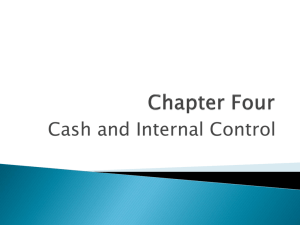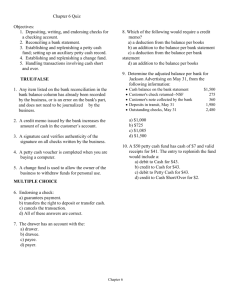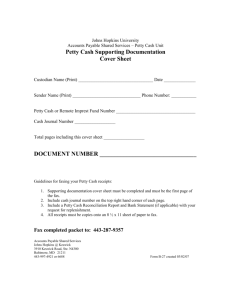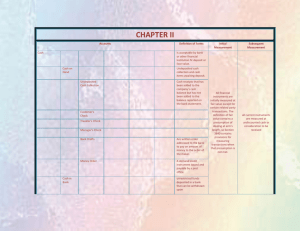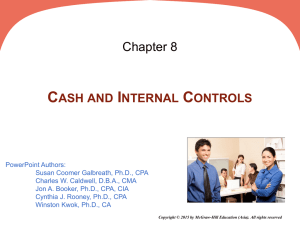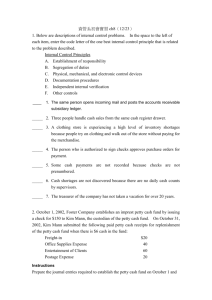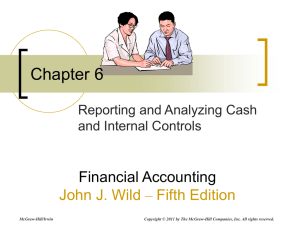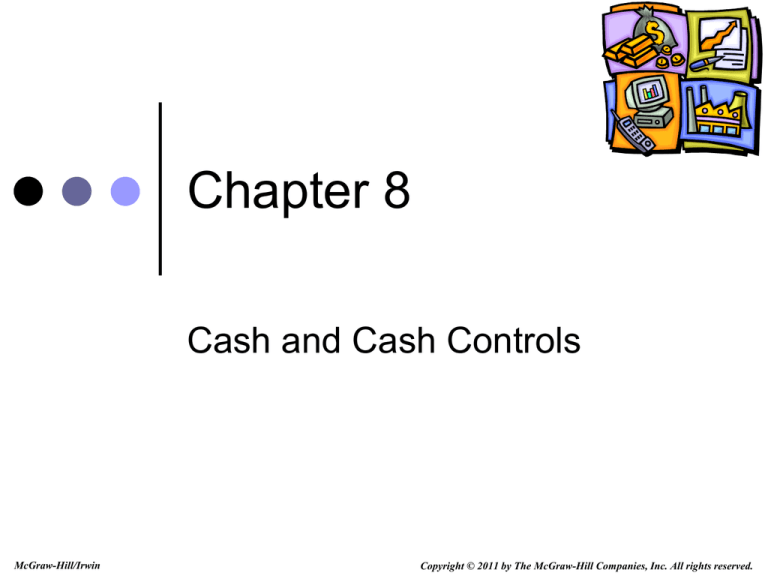
Chapter 8
Cash and Cash Controls
McGraw-Hill/Irwin
Copyright © 2011 by The McGraw-Hill Companies, Inc. All rights reserved.
Learning Objective 1
LO1
Define cash and describe three guidelines for control
of cash.
Cash includes currency and coins along
with the amounts on deposit in bank
accounts.
Control of cash focuses on three areas:
1. Those who handle cash should be separate
from those who keep records of cash.
2. Cash receipts should be deposited daily in
the bank.
3. Cash disbursements should be made by
check.
8-2
LO2
Learning Objective 2
Describe controls for cash receipts.
Cash Sales
Cash
Cash sheets
Cashier
Department
Cash
Cash sheets
Register sheets
Clerk
Register sheets
Deposit
Slip
Journal
Entry
Supervisor
8-3
LO2
Cash Over and Short
Due to human error, the cash in the cash register might not be equal to the
record of cash receipts. Assume that daily sales were shown to be $550 but
the cash count at the end of the day indicated cash in the register of $555.
The journal entry for an overage would look like this.
Cash
Cash over and short
Sales
555.00
5.00
550.00
To record cash sales and cash overage.
Now let’s assume that the register’s record shows $625 but the count
in the register is $621.The journal for a shortage would look like this.
Cash
Cash over and short
Sales
621.00
4.00
625.00
To record cash sales and cash shortage.
8-4
Learning Objective 3
LO3
Describe controls for cash disbursements
A common internal control policy is to require
that all disbursements be made by check.
Other controls include the separation of the
following duties:
Authorization for the disbursement
Check signing
Recordkeeping
Using a voucher system
8-5
Learning Objective 4
LO4
Explain and record petty cash fund transactions.
1) The company cashier processes a check for the petty cash amount and gives it
to the petty cashier.
2) Next the accountant makes an entry to debit Petty Cash and credit Cash for the
amount of the check.
3) Then the petty cashier takes the check to the bank and cashes it. The cash is
brought back and placed in a secure location.
4) As petty cash is needed, the petty cashier supplies the cash for the purchases.
5) Receipts supporting the petty cash disbursements are given to the petty
cashier.
6) When the petty cash fund is low, the petty cashier takes the receipts to the
company cashier and requests a check in that amount to replenish the petty cash
fund.
8-6
LO4
Petty Cash Example
Journal entry to replenish petty cash fund
July 31 Travel Expense
85.00
Entertainment Expense
90.00
Postage Expense
33.00
Office Supplies Expense
33.00
Cash Over and Short
Cash
2.00
243.00
8-7
LO5
Learning Objective 5
Identify banking activities as controls of cash.
Bank Accounts
Offer certain protections for your cash. For example, use of a bank
account is a more secure place for your cash than a safe at the office.
Signature Cards
Are used so the bank knows whose signature is approved for use
on checks.
Electronic
Funds
Transfer
Bank
Statements
Deposit Tickets
Checks
Limit the number of people who have their hands on the cash,
thus reducing the chance of theft and fraud.
Enable the customers the ability to reconcile their accounts in a
timely manner and notice any unusual or unauthorized activity.
Provide support for deposits to your account
.
Provide authorization for disbursements from your account.
8-8
LO6
Learning Objective 6
Describe a bank statement
The bank sends each depositor a bank statement showing the activity in the
account. Bank statements usually include:
1.Beginning-of-period balance of the
depositor’s account.
2.Checks and other debits decreasing
the account during the period.
3.Deposits and other credits
increasing the account during the
period.
4.End-of-period balance of the
depositor’s account.
Bank Statement
First National Bank
Nashville, TN 37459
May 31, 2010
Clothes Mart
Nashville, TN
Acct No 278609
Previous
Balance
Total Checks
Total
Deposits
1,488.79
5/1
5/2
5/4
5/7
1,367.09
107
2,604.22
55.00
108
109
279.50
44.75
5/9
5/12
5/15
5/18
110
111
21.81
37.55
112
175.98
5/21
5/27
5/30
5/31
113
114
288.31
12.54
Current
Balance
2,725.92
1,251.88
825.04
527.30
115
451.65
8-9
LO7
Learning Objective 7
Prepare and explain a bank reconciliation.
A bank reconciliation is prepared periodically to explain
the difference between cash reported on the bank
statement and the cash balance on a company’s books.
Bank Statement
First National Bank
Nashville, TN 37459
May 31, 2010
*
Clothes Mart
Nashville, TN
Acct No 278609
Previous Balance
Total Checks
Total
Deposits
1,488.79
5/1
5/2
5/4
5/7
1,367.09
107
2,604.22
55.00
108
109
279.50
44.75
5/9
5/12
5/15
5/18
110
111
21.81
37.55
112
175.98
5/21
5/27
5/30
5/31
113
114
288.31
12.54
115
451.65
Current
Balance
2,725.92
Account: Cash
GENERAL LEDGER
Acct. No.
1,251.88
Date
Item
May 31 Balance
PR
Debit
Credit
102
Balance
DR (CR)
2,481.18
825.04
527.30
8-10
LO7
Bank Reconciliation
Two sections:
1. Reconcile bank statement balance to
the adjusted bank balance.
2. Reconcile book balance to the
adjusted book balance.
The adjusted balances should be equal.
8-11
LO7
The July 31 bank statement indicated a balance of
$9,610.
The cash general ledger account on that date shows a
balance of $7,430.
1.
Outstanding checks totaled $2,417.
2.
A $500 check mailed to the bank for
deposit had not reached the bank at the
statement date.
3.
The bank returned a customer’s NSF
check for $225 received as payment on
account receivable.
4.
The bank statement showed $30 interest
earned during July.
5.
Check No. 781 for supplies expense
cleared the bank for $268 but was
erroneously recorded in our books as
$240.
6.
A $486 deposit by Mary, Inc. was
erroneously credited to our account by
the bank.
Matrix, Inc.
Bank Reconciliation
July 31, 2010
Bank Balance, July 31
Add: Deposit in Transit
Less: Bank Error
$ 486
Outstanding Checks 2,417
Adjusted Balance, July 31
Book Balance, July 31
Add: Interest
Less: Recording Error
NSF Check
Adjusted Balance, July 31
$
$
$
$ 28
225
$
9,610
500
(2,903)
7,207
7,430
30
(253)
7,207
8-12
LO7
Adjusting Entries from a Bank
Reconciliation
Only amounts shown on the book
portion of the reconciliation require an
adjusting entry.
July 31 Cash
30
Interest revenue
July 31 Supplies expense
Accounts receivable
Cash
30
28
225
253
8-13
End of Chapter 8
8-14


